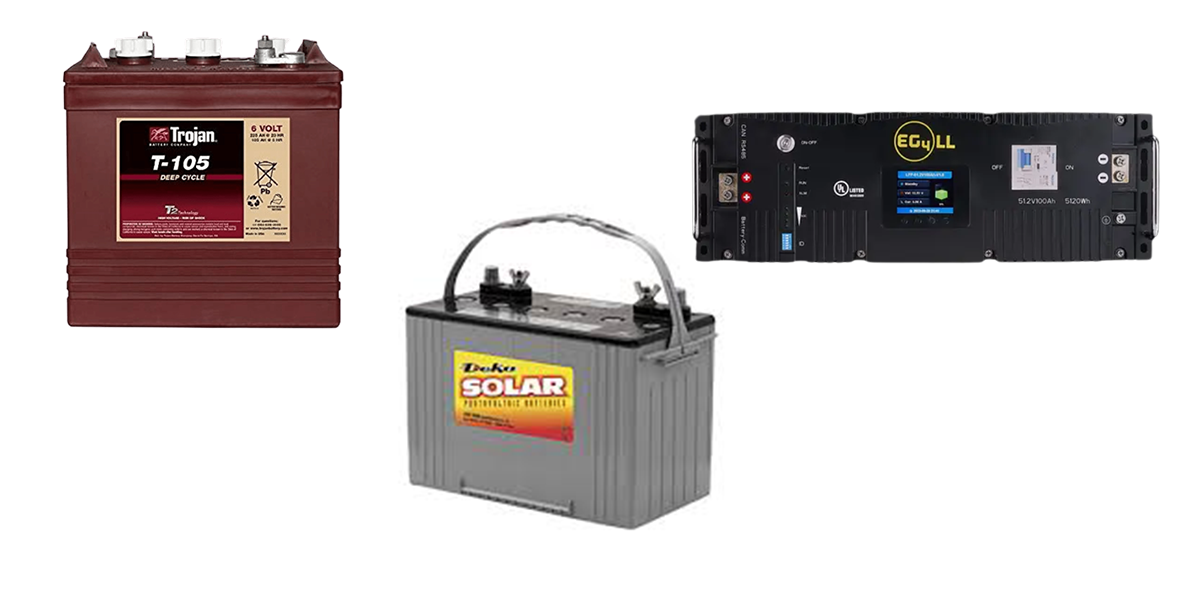Solar Battery Comparison

Flooded Lead-Acid, AGM, and Lithium Batteries
In the dynamic world of solar energy, the choice of battery is pivotal, dictating not just performance but also long-term viability and sustainability. Among the diverse options available, flooded lead-acid, AGM (Absorbent Glass Mat), and lithium batteries emerge as the top contenders. Let's unravel their unique attributes and weigh the pros and cons in the context of solar applications.
1. Flooded Lead-Acid Batteries
With a legacy dating back decades, flooded lead-acid batteries have been the backbone of solar energy storage. Their simplicity and reliability have earned them a revered status in off-grid systems and backup solutions.
Pros:
Affordability: Flooded lead-acid batteries offer a budget-friendly option for solar projects, ensuring accessibility even in economically constrained setups.
Proven Technology: With a robust and time-tested design, these batteries guarantee reliability and compatibility with existing solar setups, fostering peace of mind for users.
Resilience: Flooded lead-acid batteries exhibit remarkable tolerance to overcharging and deep discharges, making them a reliable choice in unpredictable solar conditions.
Cons:
Maintenance Demands: Regular watering, electrolyte checks, and equalization are essential for flooded lead-acid batteries, adding to the operational overhead and hassle.
Limited Lifespan: Deep discharges and improper maintenance can significantly shorten the lifespan of these batteries, necessitating cautious usage and periodic replacements.
Ventilation Requirements: Proper ventilation is critical to prevent the buildup of hydrogen gas during charging, requiring careful consideration in system design and installation.
2. AGM Batteries
AGM batteries represent a modern evolution of lead-acid technology, offering enhanced performance and reduced maintenance. Their sealed design and immobilized electrolyte make them a popular choice in various solar setups.
Pros:
Maintenance-Free Operation: AGM batteries eliminate the need for electrolyte checks and watering, streamlining maintenance efforts and reducing the risk of acid spills or leaks.
Durability: With improved resistance to vibration and shock, AGM batteries are ideal for mobile or rugged solar applications, ensuring reliable performance in demanding environments.
Installation Flexibility: AGM batteries can be installed in various orientations, providing greater freedom in system design and space utilization, especially in compact setups.
Cons:
Higher Initial Cost: AGM batteries come at a higher upfront cost compared to flooded lead-acid counterparts, potentially limiting their adoption in budget-sensitive projects.
Temperature Sensitivity: Extreme temperatures can affect the performance and lifespan of AGM batteries, necessitating thermal management measures in solar installations.
Depth of Discharge Limitation: Similar to flooded lead-acid batteries, AGM batteries are sensitive to deep discharges, requiring prudent usage to optimize lifespan.
3. Lithium Batteries
As the epitome of energy storage technology, lithium batteries offer unparalleled efficiency, longevity, and versatility. Their high energy density and advanced features make them a preferred choice for discerning solar enthusiasts.
Pros:
Superior Performance: Lithium batteries boast high energy density, allowing for more energy storage in a compact and lightweight package, optimizing space utilization and simplifying installation.
Longevity: With a significantly higher number of charge-discharge cycles, lithium batteries offer prolonged service life, reducing the need for frequent replacements and maintenance.
Fast Charging: Lithium batteries support rapid charging, enabling quick replenishment of stored energy from solar panels or grid power, enhancing overall system efficiency.
Cons:
Higher Initial Investment: Lithium batteries come with a premium price tag upfront, which may deter budget-constrained users, particularly in larger solar installations.
Complexity: Sophisticated battery management systems (BMS) are required to monitor and control charging and discharging parameters, adding to the overall system complexity and cost.
Safety Considerations: While rare, lithium batteries pose a risk of thermal runaway and fire if mishandled, necessitating robust safety measures and precautions in solar setups.
In conclusion, flooded lead-acid, AGM, and lithium batteries each offer a unique blend of advantages and considerations for solar energy storage. While flooded lead-acid batteries charm with their affordability and reliability, AGM batteries allure with their maintenance-free operation and durability. Meanwhile, lithium batteries dazzle with their unmatched performance and longevity. When selecting the ideal battery for solar applications, it's essential to weigh these factors against specific project requirements, budget constraints, and long-term sustainability goals to ensure optimal performance and return on investment.
Watch Video


